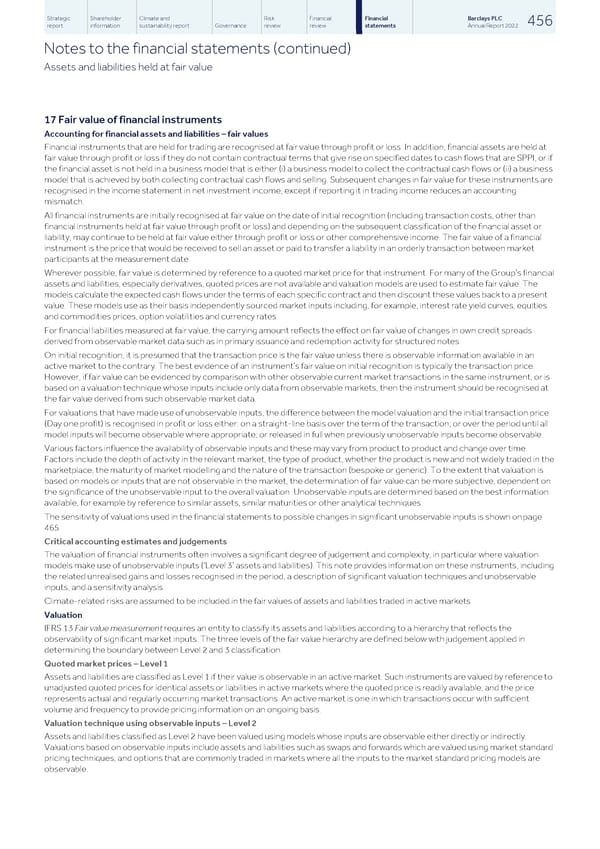Strategic Shareholder Climate and Risk Financial Financial Barclays PLC 456 report information sustainability report Governance review review statements Annual Report 2022 Notes to the financial statements (continued) Assets and liabilities held at fair value 17 Fair value of financial instruments Accounting for financial assets and liabilities – fair values Financial instruments that are held for trading are recognised at fair value through profit or loss. In addition, financial assets are held at fair value through profit or loss if they do not contain contractual terms that give rise on specified dates to cash flows that are SPPI, or if the financial asset is not held in a business model that is either (i) a business model to collect the contractual cash flows or (ii) a business model that is achieved by both collecting contractual cash flows and selling. Subsequent changes in fair value for these instruments are recognised in the income statement in net investment income, except if reporting it in trading income reduces an accounting mismatch. All financial instruments are initially recognised at fair value on the date of initial recognition (including transaction costs, other than financial instruments held at fair value through profit or loss) and depending on the subsequent classification of the financial asset or liability, may continue to be held at fair value either through profit or loss or other comprehensive income. The fair value of a financial instrument is the price that would be received to sell an asset or paid to transfer a liability in an orderly transaction between market participants at the measurement date. Wherever possible, fair value is determined by reference to a quoted market price for that instrument. For many of the Group’s financial assets and liabilities, especially derivatives, quoted prices are not available and valuation models are used to estimate fair value. The models calculate the expected cash flows under the terms of each specific contract and then discount these values back to a present value. These models use as their basis independently sourced market inputs including, for example, interest rate yield curves, equities and commodities prices, option volatilities and currency rates. For financial liabilities measured at fair value, the carrying amount reflects the effect on fair value of changes in own credit spreads derived from observable market data such as in primary issuance and redemption activity for structured notes. On initial recognition, it is presumed that the transaction price is the fair value unless there is observable information available in an active market to the contrary. The best evidence of an instrument’s fair value on initial recognition is typically the transaction price. However, if fair value can be evidenced by comparison with other observable current market transactions in the same instrument, or is based on a valuation technique whose inputs include only data from observable markets, then the instrument should be recognised at the fair value derived from such observable market data. For valuations that have made use of unobservable inputs, the difference between the model valuation and the initial transaction price (Day one profit) is recognised in profit or loss either: on a straight-line basis over the term of the transaction; or over the period until all model inputs will become observable where appropriate; or released in full when previously unobservable inputs become observable. Various factors influence the availability of observable inputs and these may vary from product to product and change over time. Factors include the depth of activity in the relevant market, the type of product, whether the product is new and not widely traded in the marketplace, the maturity of market modelling and the nature of the transaction (bespoke or generic). To the extent that valuation is based on models or inputs that are not observable in the market, the determination of fair value can be more subjective, dependent on the significance of the unobservable input to the overall valuation. Unobservable inputs are determined based on the best information available, for example by reference to similar assets, similar maturities or other analytical techniques. The sensitivity of valuations used in the financial statements to possible changes in significant unobservable inputs is shown on page 465. Critical accounting estimates and judgements The valuation of financial instruments often involves a significant degree of judgement and complexity, in particular where valuation models make use of unobservable inputs (‘Level 3’ assets and liabilities). This note provides information on these instruments, including the related unrealised gains and losses recognised in the period, a description of significant valuation techniques and unobservable inputs, and a sensitivity analysis. Climate-related risks are assumed to be included in the fair values of assets and liabilities traded in active markets. Valuation IFRS 13 Fair value measurement requires an entity to classify its assets and liabilities according to a hierarchy that reflects the observability of significant market inputs. The three levels of the fair value hierarchy are defined below with judgement applied in determining the boundary between Level 2 and 3 classification. Quoted market prices – Level 1 Assets and liabilities are classified as Level 1 if their value is observable in an active market. Such instruments are valued by reference to unadjusted quoted prices for identical assets or liabilities in active markets where the quoted price is readily available, and the price represents actual and regularly occurring market transactions. An active market is one in which transactions occur with sufficient volume and frequency to provide pricing information on an ongoing basis. Valuation technique using observable inputs – Level 2 Assets and liabilities classified as Level 2 have been valued using models whose inputs are observable either directly or indirectly. Valuations based on observable inputs include assets and liabilities such as swaps and forwards which are valued using market standard pricing techniques, and options that are commonly traded in markets where all the inputs to the market standard pricing models are observable.
 Barclays PLC - Annual Report - 2022 Page 457 Page 459
Barclays PLC - Annual Report - 2022 Page 457 Page 459